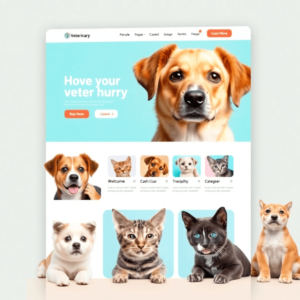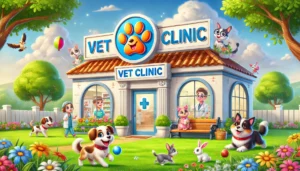Introduction
In 2024, using paid ads for veterinary clinics will be crucial in adapting to the changing digital marketing landscape. Effective marketing strategies are no longer optional but essential for clinics aiming to succeed amidst fierce competition.
The Competitive Landscape
Veterinary services are experiencing a rise in demand due to an increase in pet ownership. Households are prioritizing pet health, resulting in a crowded market where standing out requires strategic advertising. Clinics must set themselves apart through innovative marketing tactics.
The Growing Demand
Pet owners today seek quality veterinary care, and they’re willing to invest in their pets’ well-being. This growing demand emphasizes the significance of visibility and engagement through targeted digital marketing efforts. Paid ads provide a direct pathway to capture the attention of potential clients actively searching for veterinary services.
Why Effective Marketing Matters
- Visibility: In a saturated market, visibility is key. Paid ads ensure your clinic appears prominently in search results and social media feeds.
- Client Attraction: Targeted advertising helps attract new clients by reaching specific demographics aligned with your services.
- Retention: Engaging ads not only attract but also retain clients by keeping your clinic top-of-mind for ongoing pet care needs.
By adopting a forward-thinking approach to digital marketing, veterinary clinics can leverage the power of paid ads to drive growth and establish a strong market presence in 2024.
Understanding PPC Advertising for Veterinary Clinics
Definition and Mechanics of PPC Advertising
Pay-Per-Click (PPC) advertising is a digital marketing strategy where advertisers pay a fee each time their ad is clicked. It’s a way of buying visits to your site rather than attempting to earn those visits organically. PPC ads appear prominently on search engine results pages (SERPs), social media platforms, and other websites.
How PPC Works Specifically for Veterinary Practices
For veterinary clinics, PPC can be tailored to target pet owners actively seeking veterinary services. By bidding on specific keywords like “veterinary clinic near me” or “emergency vet,” clinics ensure their ads appear when potential clients are searching for relevant services. This immediate visibility can drive traffic to the clinic’s website and convert searches into appointments.
The Role of Google Ads in Reaching Pet Owners
Google Ads is a pivotal platform in the realm of PPC advertising for veterinarians. It allows clinics to:
- Target Specific Demographics: Age, location, income level, and pet ownership status.
- Utilize Local Search Ads: Ensuring ads reach pet owners within the clinic’s service area.
- Leverage Display Ads: Using visuals to capture attention across Google’s vast network of partner sites.
By strategically using Google Ads, veterinary clinics can efficiently connect with pet owners at critical moments when they are most likely to seek veterinary care.
Benefits of PPC for Veterinary Clinics
1. Quick Results and Immediate Visibility
Paid ads offer immediate visibility, making them an unparalleled tool in the digital marketing arsenal. When a veterinary clinic launches a PPC campaign, their ads appear at the top of search engine results pages (SERPs) almost instantly. This rapid visibility ensures that potential clients searching for veterinary services see your clinic first, driving traffic and inquiries from day one.
2. Attracting New Clients Effectively
Client acquisition through PPC is both efficient and strategic. By targeting specific keywords such as “vet clinic near me” or “emergency pet care,” clinics can reach pet owners actively seeking immediate care for their pets. This targeted approach not only maximizes ad spend but also connects with users who are ready to convert, ensuring a higher return on investment (ROI). For instance, using Google Ads’ location targeting capabilities allows clinics to focus on local pet owners, increasing walk-ins and scheduled appointments.
3. Retaining Existing Clients via Targeted Ads
PPC isn’t just about attracting new clients; it’s also a powerful tool for retaining existing ones. Personalized and targeted ads can remind pet owners of upcoming appointments, vaccination schedules, or special promotions tailored to their pets’ needs. For example, remarketing campaigns can target previous visitors to the clinic’s website, encouraging them to book follow-up visits or take advantage of seasonal health packages.
By leveraging these benefits, veterinary clinics can ensure sustained growth and client loyalty through smart PPC strategies.
Crafting Effective Ad Copy for Veterinary Practices
Target Audience: Pet Owners
Identifying and targeting the right audience is crucial. For veterinary clinics, this means focusing on pet owners who are actively seeking quality care for their furry companions. Using demographic data and behavioral insights helps in crafting messages that resonate deeply with pet owners’ needs.
Engaging Ad Copy
Creating engaging ad copy requires a deep understanding of what pet owners value most. This typically includes:
- Health and Safety: Emphasize the clinic’s commitment to the well-being of pets.
- Expertise: Highlight specialized services or unique qualifications.
- Convenience: Promote easy booking processes and accessible locations.
An example of an effective ad copy might be:
“Ensure your pet’s health with [Your Clinic’s Name] – the trusted choice for expert veterinary care. Book an appointment today!”
Utilizing Compelling Visuals
Visual elements significantly enhance engagement and conversion rates. High-quality images or videos of happy pets, clean facilities, and friendly staff can create an emotional connection with potential clients.
Consider these visual strategies:
- Before-and-After Shots: Showcases transformations or successful treatments.
- Staff Introductions: Humanizes the practice by featuring veterinarians and support staff.
- Client Testimonials: Video testimonials from satisfied pet owners build trust.
Using these elements thoughtfully can transform a standard PPC campaign into a compelling narrative that attracts and retains clients effectively.
With these techniques in place, veterinary clinics can craft ad copies that not only capture attention but also convert interest into action.
Setting Your Veterinary Advertising Budget
Allocating the right veterinary advertising budget is crucial for the success of your PPC campaigns. Determining a suitable budget involves understanding your clinic’s financial capacity and setting realistic goals for your ad spend.
Determining a Suitable Budget for PPC Campaigns
Begin by analyzing your clinic’s annual revenue and earmark a specific percentage for marketing. A common recommendation is to allocate 5-10% of your revenue to marketing efforts, with a portion dedicated to PPC campaigns.
Balancing Cost with Expected ROI
To achieve optimal ROI, it’s essential to balance your costs with the potential return:
- Set Clear Goals: Define what you aim to achieve—new client acquisition, increased appointment bookings, or enhanced brand awareness.
- Monitor Performance: Regularly assess the performance of your ads to ensure you’re getting value for money. Use metrics like Cost Per Click (CPC), Conversion Rate (CR), and Return on Ad Spend (ROAS) to gauge effectiveness.
- Adjust Bids Accordingly: Fine-tune your bids based on performance data to maximize ROI without overspending.
Exploring Cost-effective Advertising Strategies Tailored for Veterinarians
Cost-effective strategies can stretch your budget further:
- Geo-targeting: Focus on local clients who are more likely to visit your clinic. Utilize geo-targeted ads to reach pet owners in specific areas.
- Long-tail Keywords: Use long-tail keywords that are less competitive and more cost-effective, such as “affordable vet services in [City]” rather than generic terms.
- Seasonal Promotions: Leverage seasonal trends and promotions to attract clients during peak times, like pet wellness exams in spring or summer.
By strategically setting and managing your veterinary advertising budget, you ensure that every dollar spent contributes effectively towards growing your practice.
Implementing Google Ads for Veterinary Practices
Step-by-Step Guide to Setting Up Google Ads Campaigns for Veterinary Clinics
1. Create a Google Ads Account
- Visit the Google Ads homepage and sign up.
- Enter your business details and payment information.
2. Define Your Campaign Goals
- Choose objectives such as website traffic, lead generation, or brand awareness.
- Tailor your goals to align with your clinic’s marketing strategy.
3. Select Campaign Type
- Choose from options like Search Network, Display Network, or Video Ads.
- For veterinary clinics, Search Network campaigns often yield the best results by targeting users actively searching for services.
4. Conduct Keyword Research
- Use tools like Google Keyword Planner to identify relevant keywords.
- Focus on terms pet owners might use, such as “veterinarian near me” or “emergency vet services.”
5. Set Your Budget and Bids
- Determine daily or monthly budgets based on your financial plan.
- Choose bidding strategies like Cost-Per-Click (CPC) to manage ad spend effectively.
6. Write Compelling Ad Copy
- Craft headlines and descriptions that address pet owners’ needs.
- Include call-to-actions (CTAs) that drive engagement, such as “Book Now” or “Contact Us Today.”
7. Configure Ad Extensions
- Utilize features like location extensions, call extensions, and site link extensions.
- These additions can enhance visibility and provide more ways for potential clients to contact you.
8. Launch Your Campaign
- Review all settings and launch your ad campaign.
- Monitor performance metrics regularly to ensure goals are being met.
Importance of Keyword Research and Selection in Targeting Pet Owners Effectively
Effective keyword research is vital for ensuring your ads reach the right audience:
- Relevance: Select keywords that directly relate to veterinary services. Phrases like “dog vaccinations” or “cat dental care” attract qualified leads.
- Search Volume: Focus on high-traffic keywords but balance it with competition levels. High-search-volume keywords can drive more traffic but might be more costly.
- Long-Tail Keywords: Utilize specific phrases that capture intent, such as “affordable vet clinic in [City].” These often have lower competition yet bring highly targeted traffic.
- Negative Keywords: Exclude terms that aren’t relevant to avoid wasting budget on uninterested audiences. For example, add “free” if you don’t offer free services.
With strategic keyword research and thoughtful campaign setup, veterinary clinics can maximize their reach and connect with pet owners actively seeking their services through Google Ads.
Optimizing Your Veterinary PPC Campaigns
To get the most out of your veterinary PPC campaigns, it’s important to keep optimizing them. Here are some effective strategies and tools to make sure your ads are performing at their best.
Techniques for Ongoing Optimization
1. A/B Testing:**
- Experiment with Different Ad Copies: Run multiple versions of your ad copy to see which resonates most with pet owners.
- Test Various CTAs: Compare different calls-to-action to determine which drives the highest engagement and conversions.
- Assess Landing Pages: Evaluate different landing page designs and content to optimize user experience and conversion rates.
2. Adjusting Bids:
- Bid Modifiers: Adjust bids based on factors such as device type, location, or time of day to ensure your ads reach the right audience at the optimal moment.
- Budget Allocation: Reallocate budgets towards higher-performing keywords and ads to maximize ROI.
- Competitor Analysis: Monitor competitors’ bidding strategies and adjust your bids accordingly to stay competitive.
Leveraging AI-Driven Tools
AI-driven tools can significantly enhance the efficiency and effectiveness of PPC campaigns:
- Smart Bidding Strategies: Utilize machine learning algorithms to automatically set bids that maximize conversions or conversion value.
- Predictive Analytics: Leverage AI to forecast campaign performance trends and make data-driven decisions for future optimizations.
- Automated Ad Customization: Use AI to tailor ad content dynamically based on user behavior and preferences, increasing relevance and engagement.
Incorporating these techniques ensures your veterinary PPC campaigns stay ahead of the curve, driving growth and engagement in a competitive landscape.
Combining SEO and PPC Strategies
Combining SEO and PPC strategies becomes clear when clinics want to maximize their online presence. Integrating these tactics can lead to a more cohesive digital marketing strategy, ensuring that veterinary practices capture both immediate and long-term audience interest.
Benefits of Integrating SEO Efforts with Paid Advertising Strategies
- Enhanced Visibility: By combining SEO and PPC, clinics can dominate search engine results pages (SERPs). Organic listings build trust, while paid ads provide instant visibility.
- Comprehensive Keyword Data: PPC campaigns generate valuable insights into which keywords drive traffic. This data can refine SEO strategies for better performance.
- Improved Click-Through Rates (CTR): The dual presence of organic and paid listings often increases CTR, as users see the clinic in multiple positions, reinforcing its credibility.
- Cost Efficiency: Leveraging insights from PPC can inform and enhance organic efforts, potentially reducing reliance on expensive paid campaigns over time.
How Content Marketing Enhances Both SEO and PPC Performance
Content marketing plays a crucial role in connecting SEO and PPC strategies:
- Authority Building: High-quality content establishes the clinic as a trusted authority in pet care. Educational articles, blogs, and videos not only rank well organically but can be used in PPC campaigns to attract targeted traffic.
- Engagement Boost: Engaging content increases dwell time on the site, signaling search engines about valuable user experiences which improve organic rankings.
- Ad Relevance: Well-crafted content ensures that landing pages are highly relevant to the ad copy, improving Quality Scores in Google Ads. This relevance reduces cost-per-click (CPC) and enhances ad performance.
Combining these strategies creates a synergistic effect where each element amplifies the other’s benefits, fostering an environment where veterinary clinics can thrive digitally.
Content Marketing within Paid Ad Strategies
Educational content is crucial for establishing authority in animal health. By creating informative articles, videos, and infographics, veterinary clinics can position themselves as trusted sources of knowledge. This not only builds credibility but also fosters trust among pet owners. For instance, creating detailed guides on common pet health issues or seasonal care tips can attract and educate potential clients.
Blogging about relevant topics enhances visibility and engagement. Regular blog posts that address frequently asked questions or provide insights into veterinary care can significantly boost a clinic’s online presence. Blog content can be seamlessly integrated into paid ad campaigns to drive traffic to the clinic’s website.
Key Benefits of Blogging:
- Increased Website Traffic: High-quality blog posts optimized for search engines can attract more visitors.
- Enhanced Engagement: Engaging and informative content keeps readers on the site longer.
- SEO Boost: Consistent blogging with targeted keywords improves search engine rankings.
To maximize the impact, consider these strategies:
- Use Visuals: Incorporate images and videos to make content more engaging.
- Promote through Ads: Use Google Ads or social media platforms to promote educational content.
- Interactive Elements: Include quizzes or interactive tools related to pet health.
By integrating educational content and blogging into paid ad strategies, veterinary clinics not only enhance their online presence but also establish long-term relationships with pet owners. This approach ensures that clinics remain top-of-mind when pet owners need veterinary services, driving both immediate and future client engagement.
Local Marketing Tactics
Veterinary clinics thrive on community engagement. Geo-targeting stands as a potent tool in reaching local clients effectively. By focusing on specific geographic areas, clinics can ensure their ads appear to potential clients who are most likely to visit their practices.
Importance of Geo-Targeting
Geo-targeting allows veterinary clinics to:
- Maximize Ad Relevance: Ads displayed to users within a specific radius around the clinic increase the likelihood of attracting local pet owners.
- Optimize Budget Allocation: Concentrating ad spend on a defined area ensures efficient use of resources, reducing wastage on irrelevant clicks.
- Enhance Personalization: Tailoring ad content to reflect local culture and needs fosters a deeper connection with the audience.
Strategies for Local Engagement through Digital Ads
Implement these strategies for effective local marketing:
- Local Keywords Integration: Use keywords like “veterinarian near me” or “pet clinic in [City Name]” to boost search visibility. Incorporate location-specific phrases in ad copy and landing pages.
- Localized Ad Campaigns: Create separate campaigns for different neighborhoods or districts within the service area. Adjust bids based on the proximity to the clinic, giving higher priority to closer locations.
- Leverage Google My Business (GMB): Optimize your GMB listing with accurate information, including address, hours of operation, and services offered. Encourage satisfied clients to leave positive reviews, enhancing local credibility.
- Utilize Social Media Platforms: Engage with local communities through targeted Facebook and Instagram ads. Share content that highlights participation in community events or partnerships with local businesses.
- Promote Special Offers and Events: Advertise exclusive discounts or free check-up days tailored for residents within specific zip codes. Host or sponsor local pet events and promote them through geo-targeted ads.
By employing these geo-targeting strategies, veterinary clinics can build a robust presence within their communities, driving both foot traffic and client loyalty.
Omni-channel Approach to Advertising
Effective advertising for veterinary clinics in 2024 goes beyond just one platform. Using an omni-channel approach makes sure your clinic is visible across different channels, combining digital advertising with traditional marketing methods like print ads.
The Power of Digital Advertising
Digital platforms such as social media and Google Ads offer precision targeting and immediate engagement. Social Media Advertising on platforms like Facebook, Instagram, and TikTok allows dynamic interaction with pet owners. These channels enable clinics to share engaging content, highlight success stories, and run targeted ad campaigns based on user behavior and interests.
The Value of Traditional Marketing
Traditional marketing methods shouldn’t be overlooked. Print ads in local newspapers or magazines still hold value, especially for reaching demographics less active online. Distributing flyers and placing ads in community bulletins can drive awareness among local pet owners who prefer tangible media.
Benefits of an Omni-channel Approach
Maintaining visibility across multiple channels provides several benefits:
- Broader Reach: Diverse advertising methods capture various audience segments. Digital ads may attract younger, tech-savvy pet owners while print ads appeal to older demographics.
- Enhanced Credibility: Consistent presence both online and offline builds trust. Clients perceive the clinic as established and reliable when they encounter its name across different platforms.
- Increased Engagement: Each platform has unique strengths. Social media fosters community interaction through comments and shares, while print ads offer lasting impressions in physical formats.
An omni-channel strategy harmonizes these elements, ensuring a cohesive brand message that resonates with all potential clients.
Navigating Privacy Regulations in Advertising
The digital advertising landscape is constantly evolving, and privacy regulations are becoming increasingly strict. Veterinary clinics must stay ahead of these changes to ensure compliance and maintain effective targeting capabilities.
Adapting Advertising Strategies
Adjusting your advertising strategies to comply with new privacy laws is crucial. This involves understanding and adhering to regulations like GDPR, CCPA, and other regional policies that govern data collection and usage. Transparency with clients about how their data is collected and used builds trust and ensures compliance.
A key shift in the industry is the move away from third-party cookies. As browsers phase out these cookies, veterinary clinics need to explore alternative methods for tracking and targeting potential clients. This may include:
- Contextual Advertising: Placing ads based on the content of a webpage rather than user behavior.
- Unified ID Solutions: Leveraging industry consortiums that provide anonymized identifiers to track user preferences.
Leveraging First-Party Data
First-party data becomes invaluable in this new landscape. By collecting data directly from interactions with your clients, you can create more personalized and relevant ad campaigns without relying on third-party cookies. Strategies to harness first-party data include:
- Client Portals: Offering online services where clients can book appointments or access pet health records.
- Loyalty Programs: Encouraging sign-ups for loyalty rewards that provide insights into client preferences and behaviors.
- Email Campaigns: Using newsletters to gather feedback and understand client needs better.
First-party data allows for precision targeting, ensuring your ads reach the right audience while complying with privacy regulations. This approach not only mitigates risks associated with regulatory non-compliance but also fosters stronger relationships with your clientele through trust and transparency.
Conclusion: Leveraging Paid Ads for Veterinary Clinics in 2024
To master paid advertising in 2024, veterinary clinics need to combine digital innovation with targeted execution. By using PPC, social media, and local SEO effectively, these clinics can gain a competitive advantage in a constantly changing market.
- Digital Advertising Growth increases visibility and attracts new clients.
- Targeted Advertising ensures marketing efforts reach the right audience.
- Content Marketing establishes authority and fosters engagement with pet owners.
Implementing these strategies not only boosts revenue but also strengthens a clinic’s reputation as a trusted provider of veterinary care. The future of veterinary marketing lies in seamlessly integrating data-driven insights with personalized client experiences. Clinics that are willing to adapt will thrive in this ever-changing environment.








